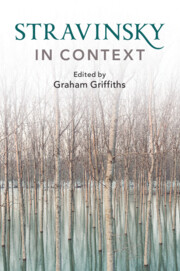Book contents
- Stravinsky in Context
- Composers in Context
- Stravinsky in Context
- Copyright page
- Contents
- Illustrations
- Contributors
- Preface
- Abbreviations
- Frontispiece
- Epigraph
- Part I Russia and Identity
- Part II Stravinsky and Europe
- Part III Partnerships and Authorship
- Part IV Performance and Performers
- Part V Aesthetics and Politics
- Chapter 23 Stravinsky versus Literature
- Chapter 24 Stravinsky and Greek Antiquity
- Chapter 25 Stravinsky’s Response to Japonisme
- Chapter 26 Stravinsky, Modernism and Mass Culture
- Chapter 27 Perspectives on Schoenberg and Stravinsky: Adorno and Others
- Chapter 28 Stravinsky’s ‘Problematic’ Political Orientation during the 1920s and 1930s
- Part VI Reception and Legacy
- Recommendations for Further Reading and Research
- Index
- Endmatter
Chapter 26 - Stravinsky, Modernism and Mass Culture
from Part V - Aesthetics and Politics
Published online by Cambridge University Press: 03 December 2020
- Stravinsky in Context
- Composers in Context
- Stravinsky in Context
- Copyright page
- Contents
- Illustrations
- Contributors
- Preface
- Abbreviations
- Frontispiece
- Epigraph
- Part I Russia and Identity
- Part II Stravinsky and Europe
- Part III Partnerships and Authorship
- Part IV Performance and Performers
- Part V Aesthetics and Politics
- Chapter 23 Stravinsky versus Literature
- Chapter 24 Stravinsky and Greek Antiquity
- Chapter 25 Stravinsky’s Response to Japonisme
- Chapter 26 Stravinsky, Modernism and Mass Culture
- Chapter 27 Perspectives on Schoenberg and Stravinsky: Adorno and Others
- Chapter 28 Stravinsky’s ‘Problematic’ Political Orientation during the 1920s and 1930s
- Part VI Reception and Legacy
- Recommendations for Further Reading and Research
- Index
- Endmatter
Summary
Noting Stravinsky’s recent interest in African American music in the Manchester Guardian, Ernest Newman remarked that Ragtime might have been better received in a cinema or restaurant. As a tribute to vapid entertainment, he averred, the piece was ‘hardly worth the while of a man of original genius’; Stravinsky, Newman claimed, had exhausted his compositional resources and – ‘having nothing urgent or vital of his own to say now’ – was busy ‘larking about boyishly among the more stereotyped musical humours of the day’.2 As a caricature of popular culture, in other words, Ragtime was beneath Stravinsky and, by extension, inappropriate fare for the concert hall. How should we understand this strange act of aesthetic transgression? Isn’t modernism supposed to maintain distinctions between ‘high’ and ‘low’?
- Type
- Chapter
- Information
- Stravinsky in Context , pp. 230 - 237Publisher: Cambridge University PressPrint publication year: 2020

